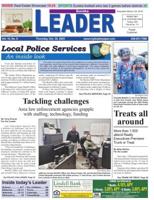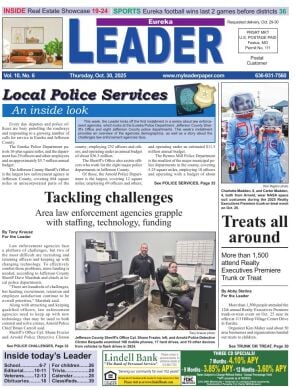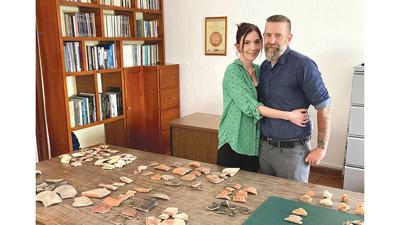It sounds more like a movie plot, but a Jefferson County native hopes to embark soon on an adventure to uncover an ancient civilization in the Amazon jungle.
If the archaeological expedition is funded, Daniel Pierce, who grew up in Imperial and graduated from St. Pius X Catholic High School in 1999, will head to the Amazon Rainforest this October, along with his colleague, Christopher Bodine of Springfield. Both are research archaeologists at Missouri State University and co-founders of the independent Terra Incognita Research Institute.
Pierce, 44, believes they will be the first researchers to explore this particular region of Brazil in the heart of the 2.3 million-square-mile rainforest.
Pierce said the two have used publicly available light detection and ranging (LiDAR) data to remotely discover evidence of ancient civilization there. He said the technology emits laser pulses from an airplane or drone to read elevations and create a detailed 3D map, adding that Bodine is an expert with LiDAR and finding data that was produced for other purposes.
“We have identified what we believe to be large geoglyphs (designs or symbols made by moving earth or arranging stones) deep in the jungle shrouded by the thick canopy,” Pierce said. “Using our LiDAR methods, we can actually see through the thick jungle trees to see the ground below. And there, we have been able to discover some amazing geometric designs built into the earth by the ancients.
“Even just two decades ago, researchers were confident that no ancient complex civilization ever existed in the Amazon. It was thought to simply be too harsh an environment. But over the past decade or so, that belief has changed, with some exciting new discoveries. And we are adding to that.”
The next step is to go to the rainforest to confirm the geoglyphs in person.
Pierce said he hopes to start the expedition in October before the five-month-long rainy season begins. It will still be a complicated and dangerous voyage that requires funding for their flights and guides.
On Aug. 26, the Missouri State University set up a monthlong Crowdfunding campaign at crowdfunding.missouristate.edu/project/47175 with a goal of raising $10,000. Pierce said donations are tax deductible.
“I think we’ll have to fly from Missouri to Bogota, Colombia, and then from Colombia to the city of Manaus in the middle of Brazil,” he said. “Then we have to hire a guide to get us like 200 miles up a river and then take a canoe another 80 miles up a tributary and then walk out in the jungle off trail like 5 miles.”
Pierce said he and Bodine have talked about taking a third person to document the expedition if there is adequate funding.
“But we are trying to keep things as cheap and quick and easy as possible,” Pierce said.
He said the two are keeping some of their information, including the exact location and timeline, vague so other explorers don’t “scoop” them.
After the initial expedition, he expects the two will publish their findings in scientific journals and then work to acquire funding for a large-scale expedition with a crew of researchers. Pierce has already published research from the U.S., Mexico, Guatemala, Belize, Honduras and Panama.
Both men have experience working in tough environments with armed guards. Bodine worked in Israel, and Pierce has spent time over the past 15 years working closely with Mexican archaeologists with the Las Animas site in western Mexico. A few years ago, through his job at the University of Central Florida, he worked in the jungle.
“It was shocking to even me that those jungles are so thick that even when you’re standing only 10 feet away from mounds and structures, sometimes you can’t see them because of the vegetation,” Pierce said. “I thought that if it’s like this here, imagine what’s hiding in the Amazon and nobody knows about it.”
He said that during his time in the jungle, each evening he read a book about Percy Fawcett, a famous explorer known for “never coming back” in 1925 from his seventh expedition to the Amazon while looking for an ancient civilization he called Z.
“Nobody, still to this day, has ever found out what happened to him,” Pierce said. “Over the past 100 years, they’ve sent about 100 people into the Amazon to try to find him, to find out what happened to him.”
Some of those people never returned, Pierce said.
He said being in the jungle reading about Fawcett inspired him to find someone to join him for an expedition there.
Pierce found 42-year-old Bodine who has degrees in anthropology, history, religious studies and geospatial science. He currently is working on a doctoral degree in archaeology at the University of Arkansas.
“It’s a chance to actually go be an Indiana Jones explorer type/archaeologist and go somewhere where not a lot of other people have gone before,” said Bodine, 42.
Both know it can be dangerous.
“It can be a very dangerous thing,” he said. “That’s why whenever we do the (large-scale expedition), we will be really selective with who we have on our team. It’s more important to have team members who physically can handle the really tough environments because we can teach them some of the science, if need be, but you can’t teach people to be able to survive a jaguar attack.”

In June, Daniel Pierce discusses a large-scale excavation of Las Animas with archaeologist Mauricio Garduno Ambriz, who discovered the site that is approximately 1,000 years old.
When Pierce describes his work, he’s worried that people think it’s fiction.
“One of the fears we have is that people don’t believe us, or that people think we’re exaggerating about this stuff because it does sound like Indiana Jones or something like that,” he said. “But that’s what it is. There’s not a lot of people, even in archeology, who do this type of work, these types of expeditions, because they are so extreme. Not just the danger of it, but there’s so much to it. It’s so crazy. But there are people in the world who do it, and we’re those people.”
Growing up in Imperial
Pierce said there weren’t a lot of kids in his neighborhood to play with while he was growing up, so he headed to the woods.
“I would play around outside a lot by myself, kind of explore the woods, get into a lot of poison ivy,” he said. “I also was really into like Native American cultures. I was obsessed with ‘Dances with Wolves’ when that came out (in 1990).”
Those interests took a pause while he studied art in college.
“I was an artist for a while,” he said.
In his mid-20s, he decided he wasn’t happy with where his life was going, so he reevaluated his interests and began reading about and watching documentaries on ancient cultures. It occurred to him that somebody has to discover these ancient civilizations.
“And I’m just as likely as anybody else to be that guy, so I’ll go ahead and give it a shot,” he said. “I started college all over … I (wanted) to see where this takes me, how far I can go with it.”
He returned to the University of Missouri-St. Louis and earned degrees in anthropology and history. Then at the University of Missouri in Columbia, he earned his master’s and doctoral degrees in anthropological archaeology.
“And now here we are, exactly 100 (years) after Fawcett’s fateful final expedition, carrying on this legacy,” he said.
This isn’t Pierce’s only research in the works.
“After the Amazon, we are going to Yellowstone to use drones to try to detect volcanic eruptions before they happen. This project will be featured in a documentary at the Cannes Film Festival. We are also planning a project to be the first to fully map the ancient city of Karakorum, which was Genghis Kahn’s first capital of the Mongolian Empire.”
Pierce hopes to inspire youth who have big dreams.
“Just because something seems like it’s only in the movies, if it’s something you want to do, if it’s your passion … somebody does that thing, and you’re just as qualified to do it as they are,” Pierce said. “Everybody started somewhere. I started as some kid in Imperial, and now I’m exploring the jungle because nobody else wanted to or nobody else thought they could. I think it shows that you don’t need to have a lot of money; you don’t need to have this big backing to follow your passions.”
For more information on the expedition, visit terraincognitaresearch.org/projects/gojira.







